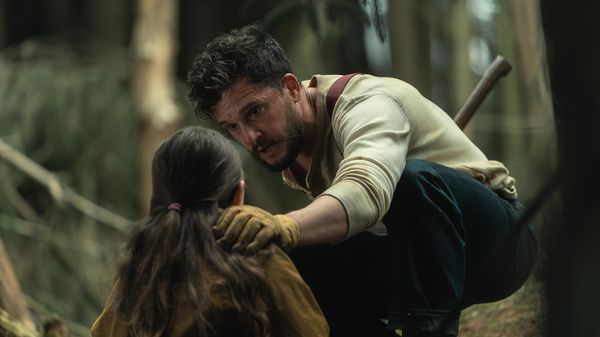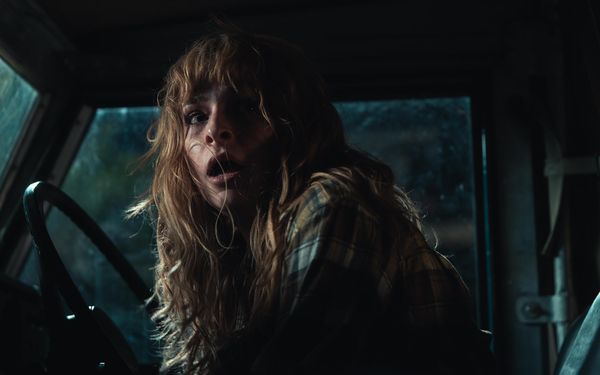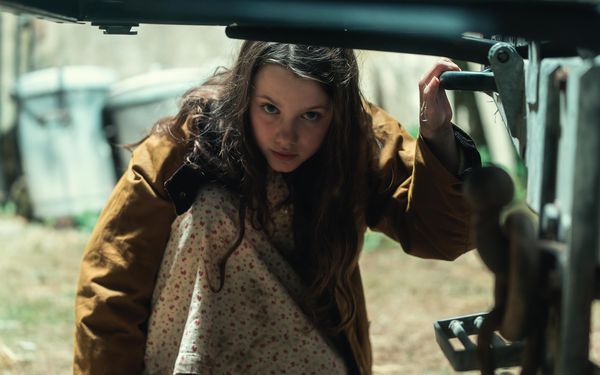 |
| Kit Harington and Caolinn Springall in The Beast Within. Alexander J Farrell: 'it's a horror film about the horrors of family life' Photo: Courtesy of Well GO USA |
Set in 1965 in rural England, Willow secretly follows her parents when they leave their fortified compound and learns the horrifying truth that her father transforms monthly from man to beast. To protect the family, Noah and Imogen continue to execute this monthly ritual, while Willow's grandfather Waylon (James Cosmo) grows increasingly impatient and warns Imogen that enough is enough. When Noah, in beast form, escapes, Willow is forced to make a choice beyond her years.
The Beast Within is Farrell's narrative feature debut and reunites him and Ellison after their 2023 documentary Making A Killing, which explored legal limitations around preventable medical negligence. His other documentaries have focused on the migration issue - Lighthouse Lesvos (2016), which was about volunteers helping refugees make safe passage at the Greek island of Lesvos, while in Refugee (2018) he followed the plight of a family of Syrian refugees, separated as they crossed Europe en route to Germany.
In conversation with Eye For Film, Farrell and Ellison discussed the film's layers of entertainment and metaphor, and their ambition to stimulate a difficult conversation.
Paul Risker: Monster movies have a metaphorical context that says something about human beings and our various anxieties. While they can be enjoyed as entertaining stories, to appreciate them fully requires us to delve into these metaphorical layers.
Alexander J Farrell: I would agree, and you can look at this film as a monster film or as a metaphor for whatever disturbance you perceive it to be. But it's still a monster film because there is a monster/man who is living in the confines of the family unit and disrupting it.
Greer Ellison: That's what made it different for us - the monster is not this external threat to the family unit. The monster is well embedded in the family and, more often than not, that's true in real life - and metaphorical conclusions of what the monster represents can be drawn from the story. A lot of creature horror films do have those metaphorical messages at their heart and that's what really interests me as a filmmaker.
AJF: Yeah, it's a horror film about the horrors of family life.
PR: The film turns the dial-up on natural and universal family tensions.
GE: Absolutely, and it's a way to open up those discussions about family through the utilisation of the horror genre. And as Alex says, this movie can be watched as a straight horror film. We're happy with that, but you can also look deeper into it and pick the metaphor apart. Either way, it's a monster film, a horror film, and a terrifying story about this one girl who is trapped in the confines of this terrible household.
PR: Is one of the reasons why horror seems effortless at dealing with deeper subjects because it offers a dual experience - escapist entertainment with a critique of themes and ideas that offers a message?
AJF: There's definitely something to be said for the unseen. The fact that Willow hears everything behind those closed doors leaves so much up to the imagination and that's what makes horror films great. And that's why we didn't want to reveal the monster until the end, because the imagination is far more powerful than anything we would be able to create. So, a lot of this film is left to the imagination and a lot of it is interpretation, especially for Willow, and that's where the horror exists in this picture.
GE: As you mentioned there Paul, using horror as an allegory and in a way it would reach right back. Alex and I love the old fairy tales and even old Aesop's Fables. It's a way of delivering a metaphor and message palatably to the audience and that's what we really like.
PR: In this type of story, you'd typically have more of a build-up to show the father's conflict. Instead, the child's point of view dominates the film.
GE: One of the things that was super important to us when we were writing the script and making the film was to stay true to Willow's perspective and to not break away from it. When we see anything fantastical or a true form of horror in the fantastical sense, it's through Willow's point of view. That blurs the line between fantasy and reality, fact and metaphor. So, it was important to us to have that unreliable narration of a child to tell this story.
PR: Kids are the ones that are supposed to pretend and dream, but The Beast Within reverses this. Instead, the adults are the ones trying to pretend and are lying to themselves, while Willow is trying to expose and understand the truth. It critiques the clichéd narrative of the differences between adulthood and childhood and the ignorance adults have towards children.
AJF: We're going on that journey with Willow from childhood into premature adulthood, where she is being forced to grow up far too quickly and has to make decisions that nobody should have to make. And yes, it is the family, the mother and the father who are pretending and that's a deep conversation. There's a lot of coercion, control, and manipulation. This is not a household Willow can just walk away from because, if it were, she would. If she could see it for what it was, there would be no threat because they wouldn't be living with this man. And it's a very good point you make.
GE: I agree that none of the characters in this film are able to leave and escape the powers of the father - not even the grandfather. It's only through Willow being forced to grow up that this family will stand a chance of a different life.
PR: People have a way of struggling to remove themselves from a situation and find themselves emotionally entrenched. In cases of abuse, the outside point of view is to just leave, but it's not that easy for the victim. The Beast Within attempts to communicate an emotional awareness and empathy.
AJF: It's definitely not an easy piece of advice to follow. There are so many nuances involved, especially in this household. When you're living in an abusive family, everything becomes muddled and twisted, and you can't see the wood for the trees. You don't know what the right thing to do is and part of this was based on my experiences as a kid living in a house with a monster. I can tell you, what you think would be an easy decision to make or an easy choice for your safety is never so.
GE: This film is all about the shades of grey within these characters and nothing is as clear-cut as it seems from the outside. The film gives us a chance to get right in there with a family and experience it for ourselves.
PR: The experiences of the family all feed into trauma and post-traumatic stress disorcer. Cinema can be a powerful means to encourage an engaging conversation to educate and reimagine what trauma is and emphasise the importance to not be afraid of your vulnerability.
AJF: Some of the deepest and most painful wounds are the ones that you can't see. That trauma and PTSD you talk of, I certainly had it and I probably still do.
Look, I don't know how personal I want to go with this - it's a battle for me knowing how much I want to say about this picture [personally] knowing that. To not shirk from your vulnerabilities is a really great way to put it. And, not feeling ashamed and starting a conversation is what we want from this film. We want the audience to walk away and have a conversation. If it gives a little bit of insight into what some families are tragically experiencing, then I think we've done our job, even if it only gets a few people talking.
GE: Coming away from this film and having a conversation with friends and family about the realms of these difficult topics is hugely important. Throughout history, these types of difficult conversations have always started in the arts and, in one form or another, in storytelling. This is something that we hope will come from this as well as being a terrifying movie and a thrill ride.
The Beast Within recently screened at the Fantasia International Film Festival, and was released theatrically in the US on Friday 26 July. It will be released on Digital Platforms in the UK on Monday 19 August by Signature Entertainment. Watch the trailer here.























